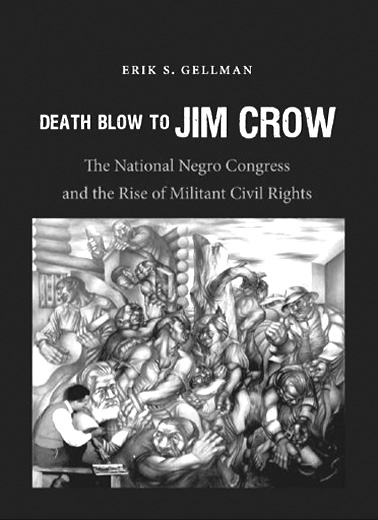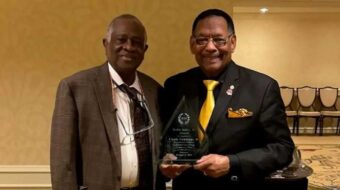
At its peak, the National Negro Congress (NNC) included over 3,000 civic, religious, fraternal, labor and community organizations representing millions people. It came to be recognized as one of the most important African American-led civil and workers’ rights organizations of the Popular Front period, and ultimately laid the groundwork for what would eventually become the modern civil rights movement of the 1960’s.
Erik S. Gellman’s “Death Blow to Jim Crow: The National Negro Congress and the Rise of Militant Civil Rights” details how an unlikely convergence of interests brought mainstream, moderate and radical African American leaders together to form the NNC.
Born out of a 1935 meeting at Howard University, initiated by John P. Davis – a communist – and attended by Communist Party leader James W. Ford and socialist A. Philip Randolph, along with about 150 other, more moderate African American leaders from the NAACP to the Urban League, the NNC soon became a force to be reckoned with.
In 1936, the NNC held its founding convention attended by 750 delegates from 28 states and elected Randolph as NNC president and Davis as executive secretary.
Gellman briefly describes the founding of the NCC, then quickly moves forward to analyze specific NNC-led campaigns and struggles in Chicago, IL, Richmond, VA, Washington, D.C., New York, NY and Columbia, SC. The author also includes a brief chapter on the 1940 NNC Convention and Randolph’s ignominious departure from the NNC, as well as a conclusion on the NNC during the post-WWII period, its dismantling and eventual merger with the communist-led Civil Rights Congress.
From its inception, the NNC had a uniquely working-class character and approach to organizing, especially union organizing. “The NNC sought to cross-pollinate its labor approach by highlighting the history of the black working class through cultural means,” while holding steadfast in the “belief that justice came from economic power.”
To that end, Davis met with CIO (Congress of Industrial Organizations) leaders to “persuade” them to “coordinate with the NNC to get African American workers into this larger coalition,” as we “needed to avoid the disastrous racial splintering” that had doomed earlier labor organizing campaigns and strikes.
Roughly one month after its founding convention, the NNC, with CIO help, had seven full-time organizers dedicated to building the movements for racial equality and workers’ rights. Eventually, the NNC would grow to about 70 chapters nationwide.
The NNC, however, did not stop with simply organizing African Americans into unions. They aggressively fought for equality within unions, while articulating a larger vision of social movement unionism that included community activism and municipal politics.
Davis wrote: “Once Negro workers are in the union…it must be our task and theirs to see to it that there is complete trade union democracy,” a sentiment that would soon put the NNC – and its communist leadership – at odds with more conservative elements within the CIO’s white leadership who were happy to welcome NNC organizers and members, as well as communists, as long as they didn’t go too far.
“…[A]s early as 1937, the goals of SWOC [the Steelworkers’ Organizing Committee of the CIO] and the NNC clashed. Davis hoped for SWOC members to lead civil rights campaigns beyond the shop floor, but SWOC’s [leadership] thought that type of activity would endanger the goal of organizing workers.” SWOC members were even told “that they should not attend meetings of other organizations…’Forget [the] Spain situation, auto situation, and other world problems’ and spend ’24 hours a day’ organizing steelworkers,” they were told.
The NNC also pushed the AFL (American Federation of Labor) “to stop discriminating against black workers” by sponsoring the “Randolph Resolution,” named after A. Philip Randolph, which “demanded that AFL unions comply with antidiscrimination measures, to which they had long paid lip service.”
The chapter titled “Negro Youth Strike Back against the ‘Virginia Way’ in Richmond, 1937-1940,” details the founding of the Southern Negro Youth Congress (SNYC), considered by many the youth section of the NNC, and its largely communist leadership – James Jackson, Esther Cooper, Edward Strong, Christopher Columbus Alston, among others.
The SNYC, like its parent organization, wasted little time in confronting Jim Crow and capitalism head-on. Shortly after its founding the convention, SNYC started organizing Richmond’s tobacco workers and after a wave of strikes helped form the Tobacco Stemmers and Laborers Union (TSLU), which would grow to about 5,000 mostly African American women members and was led by communist Christopher Alston.
“Death Blow to Jim Crow” tells an important story of the long civil rights movement, a story largely forgotten, and a story too big and nuanced to tell in a short review. Suffice it to say, I have only scratched the surface of what “Death Blow to Jim Crow” has to offer.
My only criticism: Early in “Death Blow to Jim Crow” (p 55), Gellman draws a largely superficial – and I would argue, petty – distinction between the role of Communist Party leaders as opposed to rank-and-file CP members in the building of the NNC. That CP leaders, like Ford, could not be everywhere at all times, and ultimately relied heavily on rank-and-file CP activists at the grassroots to build the NCC, should be seen as a strength, not a weakness of the CP’s overall approach to Popular Front unity. That the Party as a whole – and especially, its African American base – could take credit for and be proud of their role in building the NNC, is obscured by Gellman’s distinction and adds little to what is otherwise an objective study that tells a very important story.
For anyone interested in the National Negro Congress and its work, “Death Blow to Jim Crow” comes highly recommended.
“Death Blow to Jim Crow: The National Negro Congress and the Rise of Militant Civil Rights”
By Erik S. Gellman
University of North Carolina Press, 368 pages, 2 maps, notes, index
Available in Hardcover, paperback, an Kinle edition












Comments